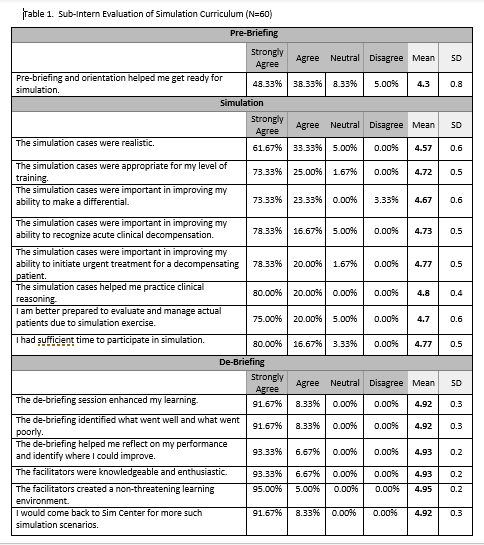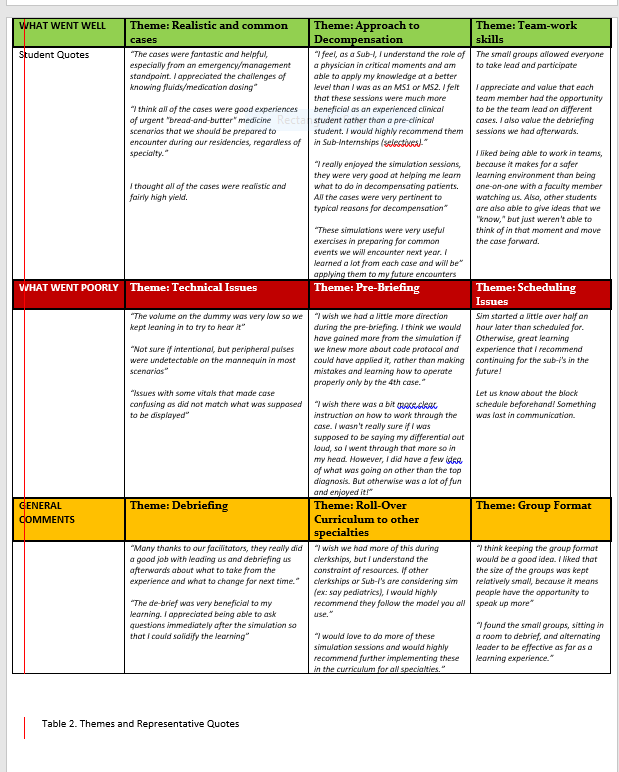Background: The ability to recognize a patient requiring urgent or emergent care and initiate evaluation and management is one of the core Entrustable Professional Activities (EPA 10). Interns are also expected to work as part of an interprofessional team (EPA 9). The exposure to common, urgent internal medicine (IM) scenarios is inconsistent throughout the IM sub-internship rotation. Controlled, high fidelity simulation may provide a good medium to evaluate students’ ability to recognize and stabilize decompensating patients and to assess teamwork skills.
Purpose: IM sub-internship student evaluations from the 2018-19 academic year called for more hands-on experience with acute patient care scenarios. Based on this feedback, simulation certified hospital medicine faculty designed an educational curriculum involving five high fidelity patient scenarios (upper GI bleed, community acquired pneumonia, diabetic ketoacidosis, acute coronary syndrome and pulmonary embolism) to assess student performance on EPAs 9 and 10 and to deliver targeted feedback and teaching during de-briefing.
Description: Students enrolled in the IM sub-internship participated in simulation exercises utilizing a high-fidelity mannequin either in groups of 4 (N=49) or as individuals (N=20). Students were pre-briefed on the simulation environment including verbalizing their thought processes during the case. One faculty played the role of a nurse in the simulation room while another faculty observed and recorded student responses in control room. Afterwards, both faculty led a debrief session where students verbalized their reasoning, areas that went well and poorly and reflected on their performance. Faculty provided specific feedback based on student performance.Course evaluations asked students to evaluate the efficacy of pre-briefing, simulation and de-briefing on a 5-point Likert scale (strongly agree to strongly disagree). The evaluation also contained a comments section where students could free text (1) what went well (2) what could be improved and (3) general feedback. We collected and analyzed both the quantitative and qualitative data. Descriptive statistics were used to analyze quantitative data. Themes and representative quotes were extracted from qualitative data.60 of 69 (86.9 %) students completed the evaluation.Overall, the course was very highly rated (Table 1). The de-briefing was the highest rated component of the simulation exercise. 93.3% of the students strongly agreed that the de-briefing helped them to reflect on their performance and to identify where they could improve. Hospital Medicine faculty facilitators were highly rated. 95.0% of students strongly agreed that simulation faculty were knowledgeable, enthusiastic and created a non-threatening learning environment. 91.7% of students strongly agreed that they would return for more similar, simulation sessions.Qualitative data revealed several themes (Table 2) that may inform future educational curricula.
Conclusions: Our educational curriculum focused on EPAs 9 and 10 was very well received by our students. High fidelity simulation provides a promising medium to teach sub-interns how to recognize urgently decompensated patients, how to stabilize them and how to work in teams. When designing simulation-based curricula for sub-interns involving decompensating patients, it is important to keep the scenarios realistic and common, focus on teamwork skills and aim for effective pre-briefing and de-briefing.


